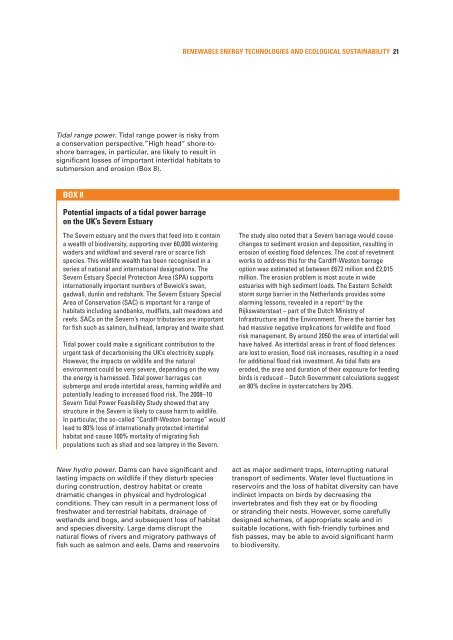Meeting Europe's renewable energy targets in harmony with - RSPB
Meeting Europe's renewable energy targets in harmony with - RSPB
Meeting Europe's renewable energy targets in harmony with - RSPB
You also want an ePaper? Increase the reach of your titles
YUMPU automatically turns print PDFs into web optimized ePapers that Google loves.
RENEWABLE ENERGY TECHNOLOGIES AND ECOLOGICAL SUSTAINABILITY 21<br />
Tidal range power. Tidal range power is risky from<br />
a conservation perspective.”High head” shore-toshore<br />
barrages, <strong>in</strong> particular, are likely to result <strong>in</strong><br />
significant losses of important <strong>in</strong>tertidal habitats to<br />
submersion and erosion (Box 8).<br />
BOX 8<br />
Potential impacts of a tidal power barrage<br />
on the UK’s Severn Estuary<br />
The Severn estuary and the rivers that feed <strong>in</strong>to it conta<strong>in</strong><br />
a wealth of biodiversity, support<strong>in</strong>g over 60,000 w<strong>in</strong>ter<strong>in</strong>g<br />
waders and wildfowl and several rare or scarce fish<br />
species. This wildlife wealth has been recognised <strong>in</strong> a<br />
series of national and <strong>in</strong>ternational designations. The<br />
Severn Estuary Special Protection Area (SPA) supports<br />
<strong>in</strong>ternationally important numbers of Bewick’s swan,<br />
gadwall, dunl<strong>in</strong> and redshank. The Severn Estuary Special<br />
Area of Conservation (SAC) is important for a range of<br />
habitats <strong>in</strong>clud<strong>in</strong>g sandbanks, mudflats, salt meadows and<br />
reefs. SACs on the Severn’s major tributaries are important<br />
for fish such as salmon, bullhead, lamprey and twaite shad.<br />
Tidal power could make a significant contribution to the<br />
urgent task of decarbonis<strong>in</strong>g the UK’s electricity supply.<br />
However, the impacts on wildlife and the natural<br />
environment could be very severe, depend<strong>in</strong>g on the way<br />
the <strong>energy</strong> is harnessed. Tidal power barrages can<br />
submerge and erode <strong>in</strong>tertidal areas, harm<strong>in</strong>g wildlife and<br />
potentially lead<strong>in</strong>g to <strong>in</strong>creased flood risk. The 2008–10<br />
Severn Tidal Power Feasibility Study showed that any<br />
structure <strong>in</strong> the Severn is likely to cause harm to wildlife.<br />
In particular, the so-called “Cardiff-Weston barrage” would<br />
lead to 80% loss of <strong>in</strong>ternationally protected <strong>in</strong>tertidal<br />
habitat and cause 100% mortality of migrat<strong>in</strong>g fish<br />
populations such as shad and sea lamprey <strong>in</strong> the Severn.<br />
The study also noted that a Severn barrage would cause<br />
changes to sediment erosion and deposition, result<strong>in</strong>g <strong>in</strong><br />
erosion of exist<strong>in</strong>g flood defences. The cost of revetment<br />
works to address this for the Cardiff-Weston barrage<br />
option was estimated at between £672 million and £2,015<br />
million. The erosion problem is most acute <strong>in</strong> wide<br />
estuaries <strong>with</strong> high sediment loads. The Eastern Scheldt<br />
storm surge barrier <strong>in</strong> the Netherlands provides some<br />
alarm<strong>in</strong>g lessons, revealed <strong>in</strong> a report iii by the<br />
Rijkswaterstaat – part of the Dutch M<strong>in</strong>istry of<br />
Infrastructure and the Environment. There the barrier has<br />
had massive negative implications for wildlife and flood<br />
risk management. By around 2050 the area of <strong>in</strong>tertidal will<br />
have halved. As <strong>in</strong>tertidal areas <strong>in</strong> front of flood defences<br />
are lost to erosion, flood risk <strong>in</strong>creases, result<strong>in</strong>g <strong>in</strong> a need<br />
for additional flood risk <strong>in</strong>vestment. As tidal flats are<br />
eroded, the area and duration of their exposure for feed<strong>in</strong>g<br />
birds is reduced – Dutch Government calculations suggest<br />
an 80% decl<strong>in</strong>e <strong>in</strong> oystercatchers by 2045.<br />
New hydro power. Dams can have significant and<br />
last<strong>in</strong>g impacts on wildlife if they disturb species<br />
dur<strong>in</strong>g construction, destroy habitat or create<br />
dramatic changes <strong>in</strong> physical and hydrological<br />
conditions. They can result <strong>in</strong> a permanent loss of<br />
freshwater and terrestrial habitats, dra<strong>in</strong>age of<br />
wetlands and bogs, and subsequent loss of habitat<br />
and species diversity. Large dams disrupt the<br />
natural flows of rivers and migratory pathways of<br />
fish such as salmon and eels. Dams and reservoirs<br />
act as major sediment traps, <strong>in</strong>terrupt<strong>in</strong>g natural<br />
transport of sediments. Water level fluctuations <strong>in</strong><br />
reservoirs and the loss of habitat diversity can have<br />
<strong>in</strong>direct impacts on birds by decreas<strong>in</strong>g the<br />
<strong>in</strong>vertebrates and fish they eat or by flood<strong>in</strong>g<br />
or strand<strong>in</strong>g their nests. However, some carefully<br />
designed schemes, of appropriate scale and <strong>in</strong><br />
suitable locations, <strong>with</strong> fish-friendly turb<strong>in</strong>es and<br />
fish passes, may be able to avoid significant harm<br />
to biodiversity.
















